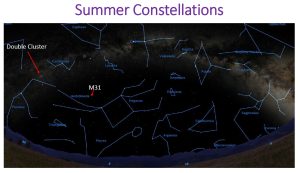The clocks have now gone back and so the nights are dark from early in the evening. The summer constellations, like Cygnus, Lyra, and Hercules are dropping into the western skies and the Milky Way is still well placed from a dark site. The winter constellations such as Orion, are now rising in the late evening by the end of the month.
Planets
Mercury
Mercury was at greatest eastern elongation of 24o on the 29th October and so starts the month as an evening object. However, its southern declination means it sets to soon after the Sun and is not well placed. It moves in towards the Sun throughout the month, going through inferior conjunction early next month
Venus
Venus is still a morning object, but is becoming very difficult. The elongation decreases to only 10o by the end of the month. The magnitude remains around -3.9, while the phase increases to 99% by the end of the month. The diameter is only around 10 arcsec. It will pass through superior conjunction next year.
Mars
Mars is technically still an evening object but is lost in the twilight.
Jupiter
Jupiter is becoming an evening object, it rises by 10 pm at the start of the month and by 8pm at the end of the month. It is a prominent object in Gemini, just below the twin stars of Castor and Pollux and is approaching opposition early in January. I recommend the website https://shallowsky.com/jupiter which shows you the position of the Galilean moons and the Great Red Spot at any time you pick.
Saturn
Saturn is past opposition now and is therefore visible throughout the night. Its magnitude is at +0.9 throughout the month, but the rings are very nearly edge on throughout the month. Although still fairly low in the sky, it can be found below the square of Pegasus. By mid month, its coordinates are: RA 23hr 46m, Dec -4o. note: As it’s a planet, it won’t twinkle like a star, making it easier to identify. You can use https://shallowsky.com to access the moons of Saturn as well.
Uranus
Uranus reaches opposition on November 21st,and is therefore well placed for observation throughout the night. It lies in Taurus with coordinates: RA 03h 50m , Dec +20o, between the Pleiades and Aldebaran.
Neptune
Neptune has just passed opposition on 23rd September and is observable throughout the night. It is not an easy object, but it can be found with coordinates: RA 00h 01m, Dec -1.5o. It is also below the square of Pegasus and not far from Saturn.
Moon Phases:
5th Nov: Full Moon 12th Nov: Last Quarter
20th Nov: New Moon 28th Nov: First Quarter
Note that Perigee (Moon at its closest) occurs on 5th November, so that will be classed as a Super moon.
Sun
The Sun is fairly active as it is still near solar maximum, so do watch out for large Sunspot groups. Remember to never look at the Sun directly without a proper solar filter.
Aurora
Aurora may be easier to see this month as the northern skies get dark much earlier. Watch out for any exceptional activity though, using one of the many aurora alert apps.
Meteors
The Leonids occur between the 6th and 30th November, with the peak on the evening of the 17th. The Zenithal Hourly Rate (ZHR) at maximum is around 15. They are typically very fast meteors that leave persistent trains. The radiant is around RA +10hr, Dec +21o. As we will be approaching new Moon, these could be very favourable.
Deep Sky Objects
The Milky Way is still well placed, passing nearly overhead. Be sure to go to as dark a site as possible if you wish to see it. Somewhere in the countryside around Guiting Power or Miserden may be the best, You can take a photo using a smart phone such as the iPhone 16. It needs to be on a tripod (or propped against something). Using night mode, you can take a 30 second single exposure. Using the Astroshader App makes the task better as it will stack in camera.
The Andromeda galaxy (M31) is very well placed, being almost overhead by mid evening. This also applies to the Double Cluster in Perseus. Both make great objects in binoculars or a small telescope and fantastic objects for astrophotography.
Neil Havard.
Any questions or for more information, contact Neil at coordassist@cotswoldas.org.uk
To view this article in PDF form, please CLICK HERE




